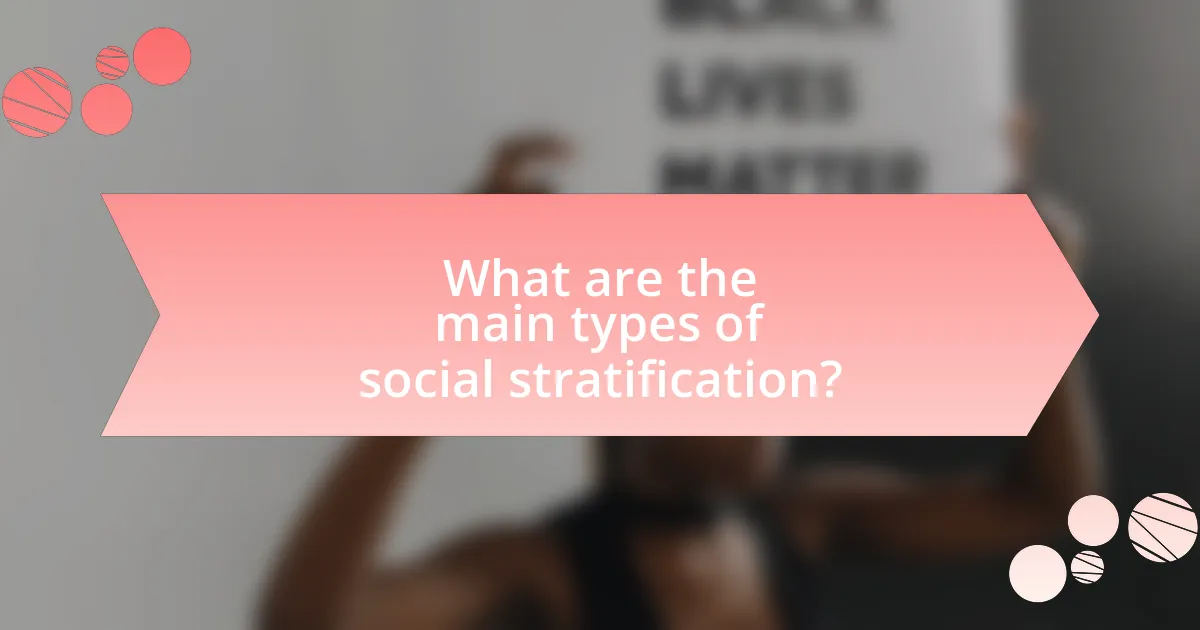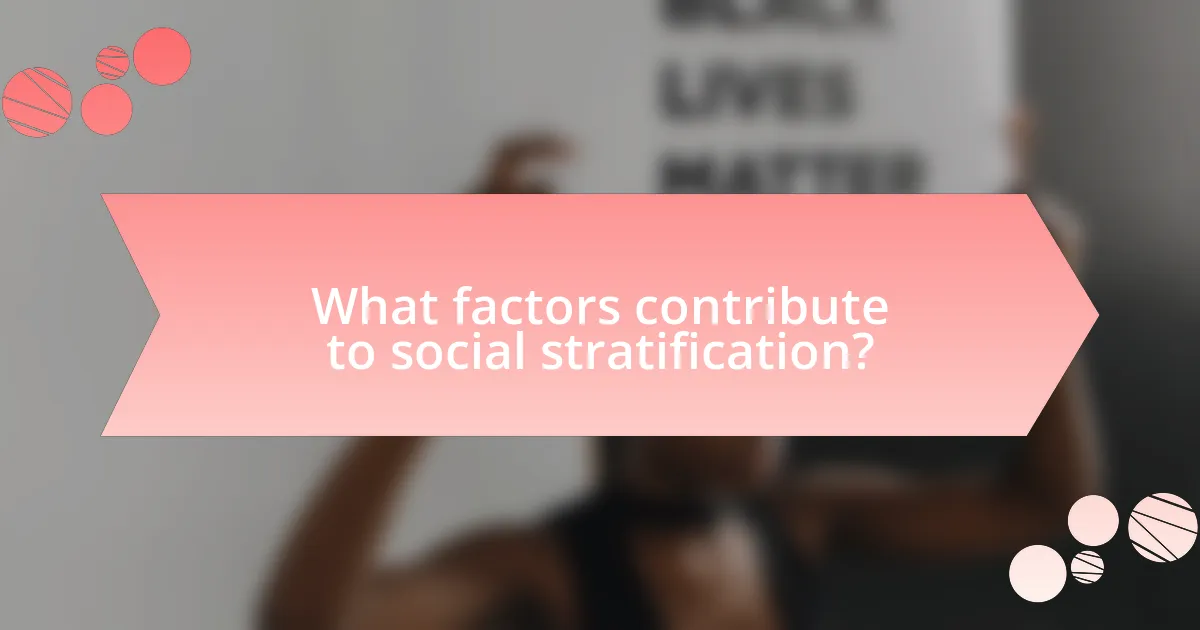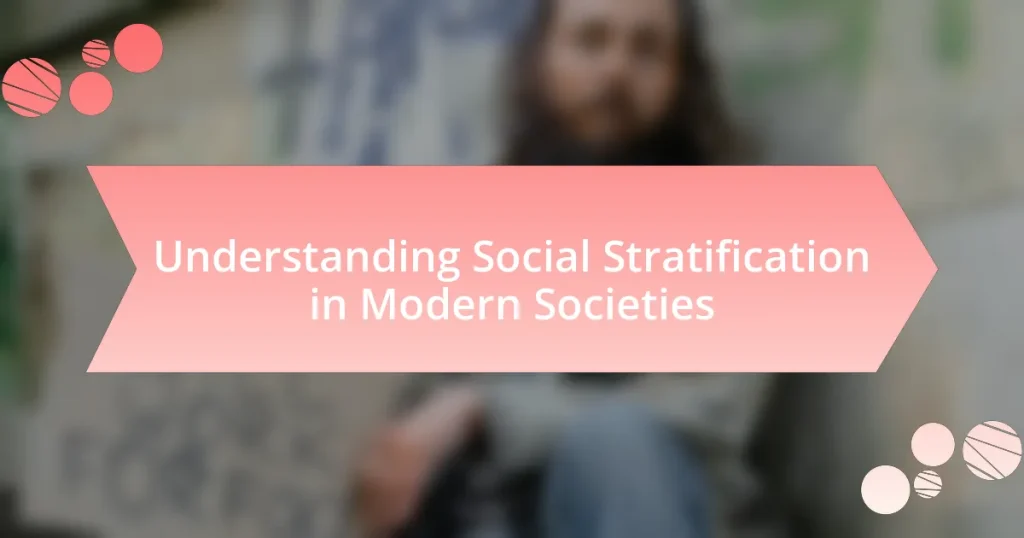Social stratification in modern societies refers to the hierarchical organization of individuals or groups based on socio-economic factors such as wealth, income, education, and occupation. This article explores the definition, characteristics, and implications of social stratification, highlighting how it varies across cultures and affects individual opportunities and societal cohesion. Key topics include the impact of class and caste systems, the role of economic factors, and the influence of globalization on social hierarchies. Additionally, the article discusses the psychological effects of living in a stratified society and presents strategies for addressing social inequality through policy changes and community initiatives.

What is Social Stratification in Modern Societies?
Social stratification in modern societies refers to the hierarchical arrangement of individuals or groups based on various socio-economic factors such as wealth, income, education, and occupation. This system categorizes people into different strata, influencing their access to resources and opportunities. For instance, in many contemporary societies, the upper class enjoys significant advantages in terms of wealth accumulation and educational access, while lower socio-economic classes often face barriers that limit their upward mobility. Research indicates that social stratification can lead to disparities in health, education, and overall quality of life, as evidenced by studies showing that individuals in lower socio-economic strata experience higher rates of chronic illnesses and lower educational attainment compared to their wealthier counterparts.
How is social stratification defined in contemporary contexts?
Social stratification in contemporary contexts is defined as the hierarchical arrangement of individuals or groups based on various socio-economic factors such as wealth, education, occupation, and power. This definition reflects the complexity of modern societies where multiple dimensions of inequality coexist, influenced by globalization, technological advancements, and changing labor markets. For instance, the World Inequality Report 2022 highlights that the top 10% of earners globally capture over half of total income, illustrating the stark economic disparities that characterize social stratification today.
What are the key characteristics of social stratification?
The key characteristics of social stratification include hierarchical organization, unequal distribution of resources, and social mobility. Hierarchical organization refers to the structured ranking of individuals and groups within a society, often based on factors such as wealth, power, and prestige. The unequal distribution of resources indicates that access to economic, educational, and social opportunities is not evenly shared, leading to disparities in quality of life. Social mobility describes the ability of individuals or groups to move within the social hierarchy, which can be influenced by factors such as education, employment opportunities, and social networks. These characteristics are evident in various societies, where studies show that income inequality has been rising, highlighting the persistent nature of social stratification.
How does social stratification differ across cultures?
Social stratification varies significantly across cultures due to differing values, economic systems, and social norms. For instance, in caste-based societies like India, social stratification is rigidly defined by hereditary classes, whereas in more egalitarian cultures, such as Scandinavian countries, social mobility is encouraged and wealth distribution is more equitable. Research by sociologist Max Weber highlights that stratification can be based on class, status, and power, which differ in emphasis depending on cultural context. In the United States, for example, social stratification is often linked to economic capital and education, while in many Indigenous cultures, social status may be derived from community roles and relationships rather than material wealth.
Why is understanding social stratification important?
Understanding social stratification is important because it reveals the hierarchical organization of society, which affects individuals’ access to resources, opportunities, and power. This stratification influences economic mobility, educational attainment, and health outcomes, as evidenced by studies showing that individuals from lower socioeconomic backgrounds often face systemic barriers that hinder their advancement. For instance, research by the Pew Research Center indicates that income inequality has been rising, leading to significant disparities in wealth accumulation and social mobility across different social classes. Understanding these dynamics is crucial for addressing social inequalities and formulating policies aimed at promoting equity and social justice.
What impact does social stratification have on individual opportunities?
Social stratification significantly limits individual opportunities by creating unequal access to resources, education, and social networks. Individuals from lower socioeconomic backgrounds often face barriers that hinder their ability to achieve upward mobility, such as inadequate educational facilities and limited job prospects. For instance, research by the Pew Research Center indicates that children from low-income families are less likely to graduate from high school and pursue higher education compared to their wealthier peers, which directly affects their future earning potential and career options. This systemic inequality perpetuates a cycle of poverty, where social class becomes a determining factor in an individual’s success and opportunities in life.
How does social stratification influence societal cohesion?
Social stratification influences societal cohesion by creating distinct social groups that can either foster unity or generate conflict. When social classes are clearly defined, individuals may develop a sense of belonging to their respective groups, which can enhance social bonds within those groups. However, significant disparities in wealth, power, and status can lead to social tensions and divisions, undermining overall societal cohesion. For instance, research by the Pew Research Center indicates that societies with high levels of income inequality often experience lower levels of social trust and increased social unrest, demonstrating that stratification can weaken the fabric of society.

What are the main types of social stratification?
The main types of social stratification are class, caste, and status. Class stratification is based on economic factors such as wealth and income, where individuals are grouped into social classes like upper, middle, and lower class. Caste stratification is a rigid system often associated with hereditary status, where social mobility is limited, as seen in traditional societies like India. Status stratification focuses on social prestige and honor, which can be influenced by factors such as occupation, education, and lifestyle, affecting individuals’ social standing regardless of their economic position. These types of stratification illustrate how societies organize individuals into hierarchies based on various criteria.
How do class systems function in modern societies?
Class systems in modern societies function by categorizing individuals into hierarchical groups based on factors such as wealth, education, occupation, and social status. These classifications influence access to resources, opportunities, and power dynamics within society. For example, in the United States, the Pew Research Center identifies three main classes: upper, middle, and lower, each with distinct economic characteristics and social mobility prospects. The upper class typically possesses significant wealth and influence, while the lower class often faces systemic barriers to advancement. This stratification is reinforced by institutions such as education and labor markets, which perpetuate inequalities and shape individuals’ life chances.
What are the defining features of a class system?
A class system is characterized by hierarchical social stratification based on economic status, occupation, education, and social prestige. In such systems, individuals are grouped into classes that influence their access to resources and opportunities. For example, in capitalist societies, the upper class typically possesses significant wealth and power, while the lower class may face economic hardships and limited social mobility. This stratification is often reinforced by cultural norms and institutional practices, such as education systems that favor certain classes over others, thereby perpetuating inequality.
How do class systems affect social mobility?
Class systems significantly restrict social mobility by creating barriers based on economic status, education, and social networks. Individuals born into lower socioeconomic classes often face limited access to quality education and job opportunities, which perpetuates their economic disadvantage. For instance, research from the Pew Research Center indicates that children from low-income families are less likely to achieve upward mobility compared to their higher-income peers, with only 7% of children from the bottom fifth of income earners reaching the top fifth as adults. This systemic inequality reinforces class divisions, making it challenging for individuals to change their social standing.
What role does caste play in social stratification?
Caste plays a significant role in social stratification by establishing rigid social hierarchies based on hereditary status. In societies like India, caste determines access to resources, social mobility, and occupational opportunities, often leading to systemic inequalities. For instance, the caste system historically categorized individuals into distinct groups, such as Brahmins, Kshatriyas, Vaishyas, and Shudras, each with specific roles and privileges. This stratification has been reinforced by cultural norms and legal frameworks, as evidenced by the Indian Constitution’s recognition of Scheduled Castes and Scheduled Tribes to address historical injustices. Consequently, caste influences social interactions, marriage patterns, and economic opportunities, perpetuating disparities in wealth and power across generations.
How is caste determined and maintained in society?
Caste is determined and maintained in society through a combination of hereditary lineage, social norms, and cultural practices. The caste system is primarily rooted in historical contexts, where individuals are born into specific castes that dictate their social status, occupation, and interactions with others. For instance, in India, the traditional four-tier system categorizes people into Brahmins, Kshatriyas, Vaishyas, and Shudras, with each group having distinct roles and responsibilities.
Maintenance of caste occurs through socialization processes, where families and communities reinforce caste identities and expectations from a young age. Additionally, endogamy, or marriage within one’s caste, serves to preserve caste boundaries and prevent social mobility. Research indicates that approximately 90% of marriages in India occur within the same caste, further solidifying these divisions (Source: “Caste in Contemporary India,” Authors: Surinder S. Jodhka and others).
Moreover, societal institutions, such as religious practices and local governance, often uphold caste distinctions, ensuring that individuals adhere to the norms associated with their caste. This combination of hereditary factors, social reinforcement, and institutional support creates a robust framework for the determination and maintenance of caste in society.
What are the implications of caste on social interactions?
Caste significantly influences social interactions by establishing rigid social hierarchies that dictate relationships and behaviors among individuals. In societies with a caste system, individuals often interact primarily within their own caste, leading to limited social mobility and restricted cross-caste relationships. This segregation can result in discrimination, social exclusion, and a lack of trust between different caste groups. For instance, studies have shown that in India, caste-based discrimination persists in various forms, affecting access to education, employment, and social services, thereby reinforcing social stratification. The implications of caste on social interactions are profound, as they shape not only personal relationships but also broader societal dynamics, perpetuating inequality and hindering social cohesion.

What factors contribute to social stratification?
Social stratification is primarily influenced by factors such as socioeconomic status, education, occupation, and social networks. Socioeconomic status, which encompasses income and wealth, determines access to resources and opportunities, thereby influencing an individual’s position in the social hierarchy. Education plays a crucial role, as higher levels of education often lead to better job prospects and higher income, reinforcing social stratification. Occupation also contributes significantly; certain professions are valued more highly than others, leading to disparities in prestige and income. Additionally, social networks can affect access to information and opportunities, further entrenching social divisions. Research indicates that these factors interact in complex ways, shaping the overall structure of social stratification in modern societies.
How do economic factors influence social stratification?
Economic factors significantly influence social stratification by determining individuals’ access to resources, opportunities, and social mobility. Wealth distribution, income levels, and employment opportunities create distinct social classes, where those with higher economic status enjoy better education, healthcare, and living conditions. For instance, data from the U.S. Census Bureau indicates that households in the top income quintile earn over five times more than those in the bottom quintile, leading to disparities in quality of life and access to essential services. This economic divide reinforces social hierarchies, as individuals from lower economic backgrounds face barriers to upward mobility, perpetuating cycles of poverty and limiting their social capital.
What is the relationship between wealth and social status?
Wealth directly influences social status, as individuals with higher wealth often enjoy greater social prestige and influence. This correlation is evident in various societies where wealth accumulation leads to increased access to resources, networks, and opportunities that enhance one’s social standing. For instance, studies show that in the United States, individuals in the top income brackets are more likely to be perceived as leaders and are often invited to exclusive social events, reinforcing their elevated status. Additionally, wealth can provide individuals with better education and healthcare, further solidifying their position in the social hierarchy.
How do employment opportunities shape social hierarchies?
Employment opportunities significantly shape social hierarchies by determining access to resources, status, and power within society. Individuals with higher-paying jobs or positions of authority often gain greater social prestige and influence, reinforcing existing class structures. For instance, research by the Pew Research Center indicates that income inequality has been rising, with the top 20% of earners in the U.S. holding more than half of the nation’s total income, which illustrates how employment opportunities can create and perpetuate disparities in wealth and social standing. Consequently, those with limited access to quality jobs may experience social marginalization, further entrenching social hierarchies.
What social and cultural factors affect stratification?
Social and cultural factors that affect stratification include socioeconomic status, education, race, ethnicity, and cultural norms. Socioeconomic status influences access to resources and opportunities, which in turn affects social mobility and class positioning. Education serves as a critical determinant of stratification, as higher educational attainment often correlates with better job prospects and income levels. Race and ethnicity can create systemic barriers and privileges, impacting individuals’ experiences and opportunities within society. Cultural norms, such as values surrounding work, family, and community, also shape social hierarchies and influence how individuals perceive and navigate their social positions. These factors collectively contribute to the complex landscape of social stratification in modern societies.
How does education impact social stratification?
Education significantly impacts social stratification by influencing individuals’ access to economic opportunities and social mobility. Higher levels of education typically correlate with better job prospects, higher income, and increased social status, thereby reinforcing existing social hierarchies. For instance, data from the U.S. Bureau of Labor Statistics indicates that individuals with a bachelor’s degree earn approximately 65% more than those with only a high school diploma, illustrating how educational attainment can lead to economic advantages that perpetuate social stratification. Additionally, educational institutions often reflect and reproduce societal inequalities, as access to quality education is frequently determined by socioeconomic status, further entrenching disparities in wealth and opportunity across different social classes.
What role does race and ethnicity play in social stratification?
Race and ethnicity significantly influence social stratification by determining access to resources, opportunities, and social status. Individuals from marginalized racial and ethnic groups often face systemic barriers that limit their economic mobility and social integration. For example, studies show that Black and Hispanic individuals in the United States experience higher rates of poverty and unemployment compared to their white counterparts, reflecting entrenched inequalities. Additionally, racial and ethnic discrimination in education and employment perpetuates these disparities, as evidenced by research from the Pew Research Center, which highlights that minority groups are often underrepresented in higher-paying jobs and overrepresented in lower-paying sectors. Thus, race and ethnicity are critical factors in shaping the hierarchical structure of society, affecting individuals’ life chances and social standing.
How does globalization affect social stratification?
Globalization increases social stratification by widening the economic gap between different social classes. As global markets expand, wealth becomes concentrated among those with access to resources, technology, and education, often leaving marginalized groups behind. For instance, the World Bank reported that the richest 10% of the global population owns over 70% of the world’s wealth, highlighting the disparity created by globalization. This economic divide leads to unequal access to opportunities, further entrenching social hierarchies and limiting social mobility for lower-income individuals.
What are the effects of global economic changes on local stratification?
Global economic changes significantly impact local stratification by altering income distribution, employment opportunities, and social mobility. For instance, globalization can lead to job displacement in traditional sectors while creating new opportunities in technology and services, resulting in a widening income gap. According to the International Labour Organization, the rise of gig economies and automation has disproportionately affected low-skilled workers, exacerbating local inequalities. Additionally, economic policies influenced by global markets can shift resources away from public services, further entrenching social stratification within communities.
How do migration patterns influence social hierarchies?
Migration patterns significantly influence social hierarchies by altering demographic compositions and economic opportunities within societies. When large groups migrate, they can shift the balance of power, resources, and cultural influence, often leading to the establishment of new social classes or the reconfiguration of existing ones. For instance, the influx of skilled migrants can elevate certain sectors of the economy, creating a demand for high-skilled labor and potentially marginalizing lower-skilled workers.
Historical evidence shows that during the Industrial Revolution, migration from rural areas to urban centers led to the rise of a working class, which challenged the existing aristocratic social structure. Similarly, contemporary studies indicate that cities with high immigration rates often experience increased economic stratification, as seen in metropolitan areas like New York and London, where immigrant communities can both thrive and face significant socio-economic challenges. Thus, migration patterns are a critical factor in shaping the dynamics of social hierarchies.
What are the consequences of social stratification in modern societies?
Social stratification in modern societies leads to significant inequalities in wealth, education, and access to resources. These inequalities result in limited social mobility, where individuals from lower strata face barriers to improving their socioeconomic status. For instance, research indicates that children from low-income families are less likely to attain higher education, perpetuating the cycle of poverty. Additionally, social stratification contributes to health disparities, as those in lower socioeconomic positions often experience poorer health outcomes due to inadequate access to healthcare and nutritious food. Studies show that income inequality correlates with increased rates of mental health issues and chronic diseases among disadvantaged groups. Thus, the consequences of social stratification manifest in various dimensions, reinforcing systemic inequalities and affecting overall societal cohesion.
How does social stratification affect access to resources?
Social stratification significantly affects access to resources by creating hierarchical divisions that determine individuals’ opportunities and privileges. Those in higher social strata typically have better access to essential resources such as education, healthcare, and employment opportunities, while individuals in lower strata face barriers that limit their access to these resources. For instance, a study by the Pew Research Center found that individuals from lower-income families are less likely to attain higher education, which directly impacts their earning potential and access to quality jobs. This disparity in access perpetuates cycles of poverty and inequality, reinforcing the social stratification system.
What are the psychological effects of living in a stratified society?
Living in a stratified society leads to significant psychological effects, including increased stress, anxiety, and feelings of inadequacy among individuals in lower socioeconomic classes. Research indicates that social stratification creates a sense of relative deprivation, where individuals compare themselves to those in higher strata, resulting in diminished self-esteem and increased mental health issues. For instance, a study published in the American Journal of Public Health found that individuals in lower socioeconomic positions reported higher levels of psychological distress compared to their wealthier counterparts, highlighting the detrimental impact of perceived social inequality on mental well-being.
What strategies can be employed to address social stratification?
Strategies to address social stratification include implementing progressive taxation, enhancing access to quality education, and promoting affordable healthcare. Progressive taxation redistributes wealth, reducing income inequality; for instance, countries like Sweden and Denmark have lower levels of income disparity due to their tax systems. Enhancing access to quality education ensures that individuals from lower socioeconomic backgrounds can acquire skills necessary for higher-paying jobs, as evidenced by studies showing that educational attainment correlates with income levels. Promoting affordable healthcare reduces financial burdens on low-income families, improving their overall quality of life and economic stability, which is supported by data indicating that access to healthcare leads to better employment outcomes.
How can policy changes reduce social inequality?
Policy changes can reduce social inequality by implementing progressive taxation, increasing access to quality education, and expanding social safety nets. Progressive taxation redistributes wealth by taxing higher incomes at greater rates, which can fund public services that benefit lower-income individuals. For example, countries like Sweden and Denmark have successfully used this approach to reduce income disparities. Increasing access to quality education ensures that all individuals, regardless of socioeconomic status, have the opportunity to improve their economic prospects. Research shows that educational attainment is strongly correlated with income levels, as seen in studies by the Organisation for Economic Co-operation and Development (OECD). Expanding social safety nets, such as unemployment benefits and healthcare access, provides essential support to vulnerable populations, helping to lift them out of poverty and reduce inequality. Evidence from the U.S. shows that states with more comprehensive social programs have lower rates of poverty and inequality.
What role do community initiatives play in promoting equality?
Community initiatives play a crucial role in promoting equality by fostering inclusive environments and providing resources to marginalized groups. These initiatives often focus on addressing systemic barriers, such as access to education, healthcare, and employment opportunities, which disproportionately affect underrepresented communities. For instance, programs like community health clinics and educational workshops have been shown to improve access to essential services, thereby reducing disparities. Research indicates that areas with active community engagement see a 20% increase in social cohesion, which directly correlates with improved equality outcomes.
